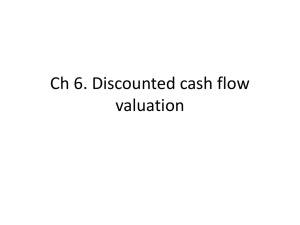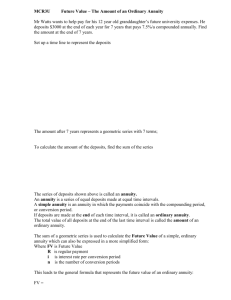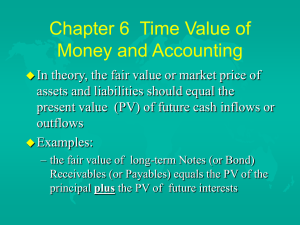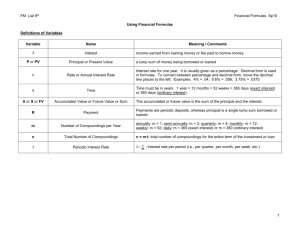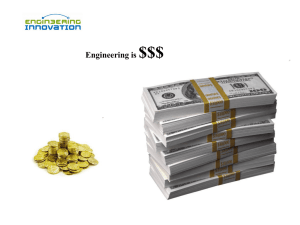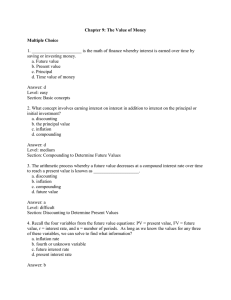ECO 4368 Instructor: Saltuk Ozerturk Time Value of Money Future
advertisement
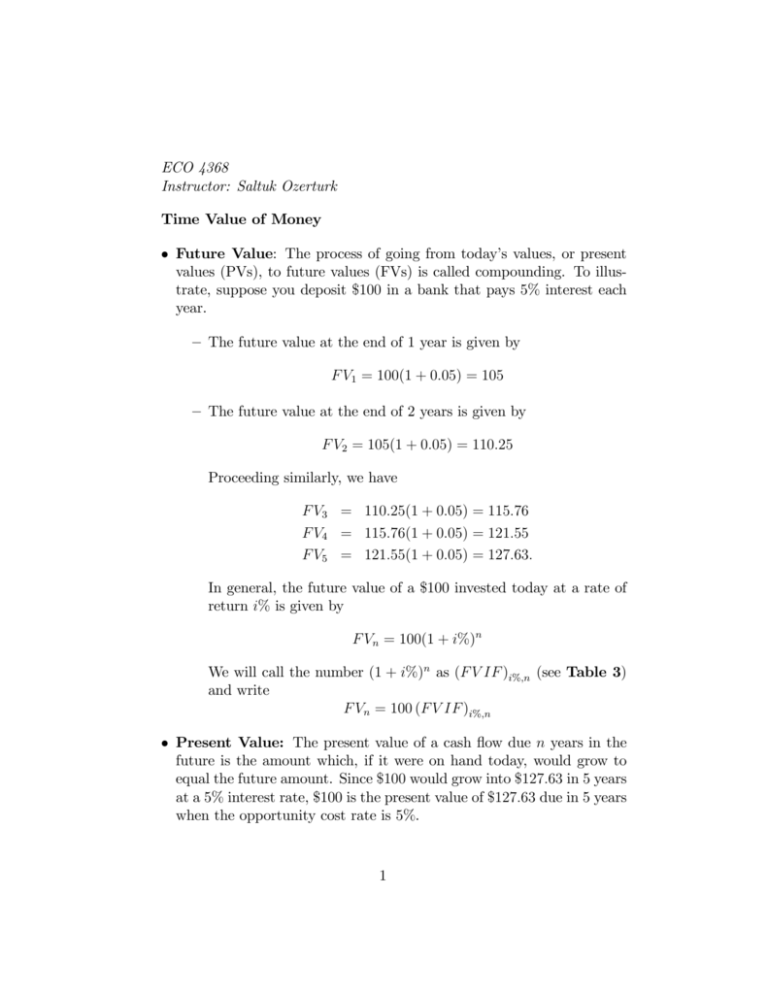
ECO 4368 Instructor: Saltuk Ozerturk Time Value of Money Future Value: The process of going from today’s values, or present values (PVs), to future values (FVs) is called compounding. To illustrate, suppose you deposit $100 in a bank that pays 5% interest each year. – The future value at the end of 1 year is given by F V1 = 100(1 + 0:05) = 105 – The future value at the end of 2 years is given by F V2 = 105(1 + 0:05) = 110:25 Proceeding similarly, we have F V3 = 110:25(1 + 0:05) = 115:76 F V4 = 115:76(1 + 0:05) = 121:55 F V5 = 121:55(1 + 0:05) = 127:63: In general, the future value of a $100 invested today at a rate of return i% is given by F Vn = 100(1 + i%)n We will call the number (1 + i%)n as (F V IF )i%;n (see Table 3) and write F Vn = 100 (F V IF )i%;n Present Value: The present value of a cash ‡ow due n years in the future is the amount which, if it were on hand today, would grow to equal the future amount. Since $100 would grow into $127:63 in 5 years at a 5% interest rate, $100 is the present value of $127:63 due in 5 years when the opportunity cost rate is 5%. 1 Note that we have the following relationship for Future and Present values: F Vn = P V (1 + i%)n which implies n 1 = F Vn 1 + i% ) P V = F Vn (P V IF )i%;n PV n 1 as (P V IF )i%;n (Present Value Interest i.e., we call the number 1+i% Factor for i and n) (see Table 1). Let us now con…rm that the $100 is the present value of $127:63 due in 5 years when the opportunity cost rate is 5%. We have (from Table 1) P V = $127:63 (P V IF )5%;5 = $127:63(0:784) = $100: Example 1: Suppose you are to receive the following cash ‡ow stream and the one period discount rate (opportunity cost rate) is 10%. What is the present value of this cash ‡ow stream? i=10% PV=? PV 1 2 3 4 $2500 $4000 $5000 = 2500 (P V IF )10%;2 + 4000 (P V IF )10%;3 + 5000 (P V IF )10%;4 = 2500(0:826) + 4000 (0:751) + 5000 (0:683) = $8484 2 Present Value of an Annuity: An annuity is a series of equal payments made at the end of …xed intervals. For example, $100 at the end of each of the next three years is a three year annuity. Payments on mortgages, car loans and students loans are typically set up as annuities. Example 2: Below is a 4 year annuity of $100, discounted at 5%. 1 i=5% PV=? $100 2 $100 3 4 $100 $100 We can …nd the present value of the above annuity by individually discounting each payment of $100. But there is an easier way. The present value is given by (See Table 2) PV = 100 (P V IF A)i%;n = 100 (P V IF A)5%;4 = 100(3:546) = 354:6 Example 3: Below is a 15 year annuity of $1000, discounted at 8%. i=8% PV=? 1 2 3 $1000 $1000 $1000 15 $1000 The present value is given by (See Table 2) PV = 1000 (P V IF A)8%;15 = 1000(8:559) = 8559 Example 4 (Missing Cash Flows): Suppose that you have an investment opportunity that pays $300 at t=1, $300 at t=2, $300 at t=3 and some …xed cash ‡ow at the end of each of the remaining 17 years (see below). 3 1 i=9% 2 $300 3 $300 $300 4 $x 5 $x 20 $x PV=$5500 The present value of this cash ‡ow stream is P V = $5500;and an alternative investment of equal risk has a required rate of return of 9%. What is the annual cash ‡ow received at the end of each of the …nal 17 years? Answer to Example 4: The present value of the above cash ‡ow stream can be written as PV = ) ) ) 300(P V IF A)9%;3 + x(P V IF A)9%;17 (P V IF )9%;3 5500 = 300(2:531) + x(8:544)(0:772) 5500 = 759:3 + 6:59x x = $718:7 Example 5: (Amortized Loan): Suppose that you borrowed $60,000 from a bank. The loan should be paid back in 4 years and the bank proposed the following payment plan: Year 1: $20,000, Year 2: $20,000, Year 3: $20,000, Year 4: $20,000 What is the interest rate on the loan? $60; 000 = 20; 000(P V IF A)i%;4 $60; 000 = (P V IF A)i%;4 ) 20; 000 ) 3 = (P V IF A)i%;4 From Table 2, i = 12% 4


